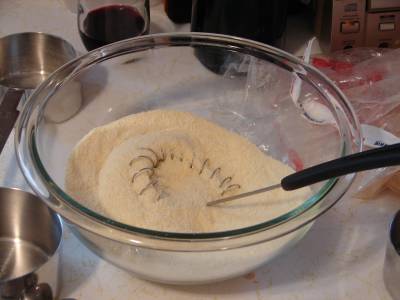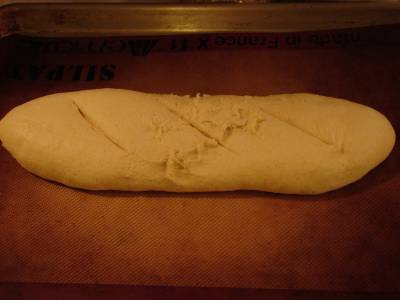Servings: 8
Total Cost: $0.93
Cost Per Serving: $0.12
Total Calories: 1,023
Calories/Serving: 128
| Ingredient | Volume | Mass | Cost | Calorie |
| Flour, Semolina, Enriched |
5/8 Cups |
100.20 Grams |
$0.29 |
361 |
| Yeast, Instant, Fast Rising |
1/8 Teaspoon |
1.00 Gram |
$0.04 |
0 |
| Water |
3/4 Cups |
170.25 Grams |
$0.00 |
0 |
| Flour, Semolina, Enriched |
1 Cup |
167.00 Grams |
$0.48 |
601 |
| Yeast, Instant, Fast Rising |
3/8 Teaspoons |
3.00 Grams |
$0.11 |
0 |
| Salt, Table |
7/8 Teaspoons |
5.25 Grams |
$0.01 |
0 |
| Flour, Bread |
2 Tablespoons |
0.53 Ounce |
$0.01 |
62 |
|
This bread, also an adaptation from Rose Levy Beranbaum’s book “The Bread Bible,” is a quite different experience, due to the sole content of durum flour (semolina flour). Regular white flour, is only used for kneading, so other than that, this bread is 100% semolina flour – a very high protein flour. The recipe called for durum flour, however we used semolina flour instead which is a coarser grind, both milled from the endospherm of durum wheat. It turned out just fine to use the coarser grind, however if you want an even finer texture, use durum flour or grind semolina flour down slightly in a mixer with a metal blade.
The texture of this loaf is very fine and the taste is delicate and almost sweet. We didn’t get as high rise as would have been optimal, but this bread was wonderful nonetheless. Served with some butter and a little honey, the flavor and the texture came through especially well. This kind of bread is fun to make just for a change, since it’s quite different to work with semolina flour as opposed to regular flour. The dough is very smooth and silky to work with and the result was more than satisfying. Dough Starter (Sponge)
2/3 cup durum flour
1/8 teaspoon instant yeast
¾ cup water, room temperature
Flour Mixture
1 cup durum flour
3/8 teaspoon instant yeast
¾ plus 1/8 teaspoon salt
1 to 2 tablespoons bread flour for kneading
Method:
1. Make the sponge the night before, by whisking durum flour, yeast and water in a bowl for about 2 minutes to incorporate air. Cover with plastic wrap. Make the flour mixture, by whisking together ¼ cup of durum flour and the yeast in a separate bowl. Then mix in the salt and add the mixture on top of the sponge and cover with plastic wrap. Let sit in room temperature for 1 - 4 hours, and possibly refrigerate up to 24 hours if it’s convenient.
2. Mix the dough together by combining the sponge and the flour mixture with a wooden spoon. Knead the dough together in the bowl until it comes together, then knead it on a floured surface for 5 minutes to develop the gluten structure, adding up to ¼ cup of flour as needed. Cover it with an inverted bowl and let rest for 20 minutes. Knead the dough for another 5 minutes until it’s very smooth. Add some additional flour if the dough is sticky.
3. Now, place the dough in a lightly greased 1-quart bowl (or dough rising container). Cover with plastic wrap and let rise until doubled, 1 ½ to 2 hours, ideally in 75 – 80 degrees. (If your kitchen is colder than that, you can put your oven on warm for a minute, then shut it off and leave the dough inside the oven for the rising period).
4. Turn the dough on a lightly floured surface, press it down and shape it into a 7-by-6-inch rectangle. Shape it into a 9-inch torpedo and place it on lined baking sheet. Cover it with oiled plastic wrap and allow to rise until almost doubled, about 1 hour to 1 hour and 15 minutes.
5. Preheat the oven to 450 degrees (it is recommended that you pre-heat the oven an hour before baking). On the lowest shelf in the oven, place a cast-iron pan or a sheet pan. Above, place a baking stone or a sheet pan.
6. Now slash the bread a couple of times, mist it with water and quickly set the baking sheet on the hot stone. Toss ½ cup of ice cubes into the pan beneath and shut the door immediately. Bake for 20 minutes, or until the bread is golden brown and an instant-read thermometer inserted into the center will read about 208 degrees. Halfway through baking, lift the bread from the pan and set it directly on the baking stone, also turn it around for even baking. Let cool on a wire rack.
|

